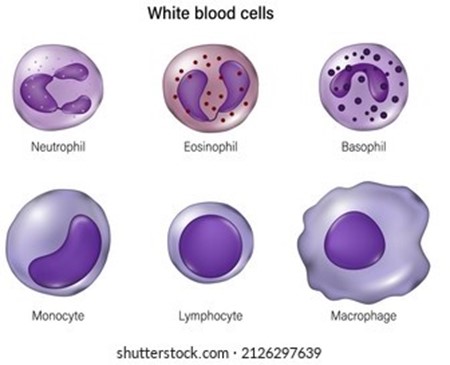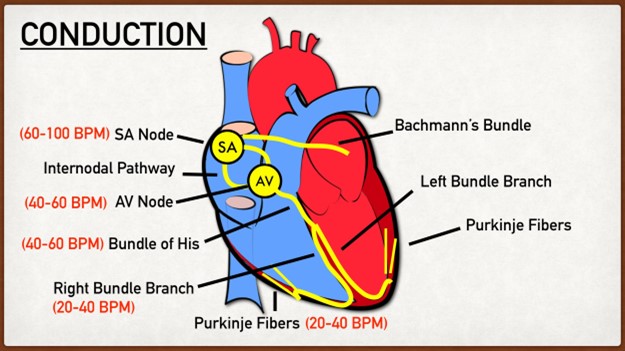While looking at a sample of blood in a microscope, you see a cell that is markedly larger than a red blood cell.
It has a bi-lobed nucleus and is filled with red granules in the cytoplasm.
What type of blood cell is this?
Basophil.
Lymphocyte.
Eosinophil.
Monocyte.
Neutrophil.
The Correct Answer is C
This type of blood cell is a granulocyte that has a bi-lobed nucleus and red granules in the cytoplasm.

Eosinophils are involved in allergic reactions and parasitic infections.
Choice A is wrong because basophils are granulocytes that have a lobed nucleus and dark blue or purple granules in the cytoplasm.
Basophils are involved in inflammatory responses and histamine release.
Choice B is wrong because lymphocytes are agranulocytes that have a large round nucleus and a thin rim of cytoplasm.
Lymphocytes are involved in immune responses and produce antibodies.
Choice D is wrong because monocytes are agranulocytes that have a kidney-shaped nucleus and a pale blue cytoplasm.
Monocytes are involved in phagocytosis and tissue repair.
Choice E is wrong because neutrophils are granulocytes that have a multi-lobed nucleus and pale pink granules in the cytoplasm.
Neutrophils are involved in bacterial infections and inflammation.
Nursing Test Bank
Naxlex Comprehensive Predictor Exams
Related Questions
Correct Answer is C
Explanation
Positive feedback mechanisms move conditions away from the normal state.

They amplify the original action and produce more of the same effect.
For example, blood clotting and childbirth are positive feedback mechanisms.
Choice A is wrong because positive feedback mechanisms usually produce unstable conditions.
They do not resist change but rather enhance it.
Choice B is wrong because positive feedback mechanisms do not cause long-term changes.
They are ultimately stopped by negative feedback loops once the process they were used for is complete.
Choice D is wrong because positive feedback mechanisms do not bring conditions back to the normal state.
That is the role of negative feedback mechanisms, which oppose the stimulus and restore homeostasis.
Correct Answer is C
Explanation

This sequence ensures that the atria contract before the ventricles and that the ventricles contract from the bottom up.
Choice A is wrong because it reverses the order of the SA node and the AV node. The SA node is the pacemaker of the heart and initiates the cardiac impulses.
Choice B is wrong because it places the Purkinje fibers before the AV node.
The Purkinje fibers are the last part of the conduction system and stimulate the ventricular muscle fibers.
Choice D is wrong because it reverses the order of the entire sequence.
The AV node is not the pacemaker of the heart and does not initiate cardiac impulses.
Whether you are a student looking to ace your exams or a practicing nurse seeking to enhance your expertise , our nursing education contents will empower you with the confidence and competence to make a difference in the lives of patients and become a respected leader in the healthcare field.
Visit Naxlex, invest in your future and unlock endless possibilities with our unparalleled nursing education contents today
Report Wrong Answer on the Current Question
Do you disagree with the answer? If yes, what is your expected answer? Explain.
Kindly be descriptive with the issue you are facing.
